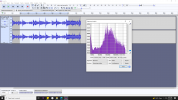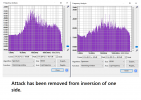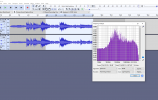So I just checked out what I THINK the samples Wenti used were and they are very bad for the purpose, very diffuse, vague LF sounds.
I tried to find what he called
"Ladysmith Black Mambozo Loop" but couldn't. It seems that is a BAND and there is no track info I could find so it can't be repeated.
Enya – Orinoco Flow seconds 2-7 maybe(that also isn't precise so can't be duplicated per Paper)
Song at bottom. this is a horrible test missing of the elements I would use to locate low frequencies.
Theme from Terminator
seconds 4-9(about)
This track also make no sense.
I put this song into audacity and plotted the spectrum for seconds 4-9 and this is the spectral content
This is THE FIRST terminator theme I found
As you can see, the majority of LF content in this sample is well over 100hz. This sample just doesn't make any sense for testing LF localization including below 80hz
View attachment 155189View attachment 155187
Here is a look at same titled "the terminator theme from youtube:
This version has a stronger "da, da, DA DA DA!"
But upon inspect, we see this issue I suspect would be in the Samples
The attack of the LF sound is missing and the diffuse sound field remains.
In a diffuse or HF/MF attenuated sound field localization is ALWAYS much harder.
View attachment 155195
View attachment 155191View attachment 155192
This will be my last post Regarding Welti's paper.
1. His test design must have music/content that contains localizable LF information.
A. To verify his samples have such information he must prove IT HAS LF content that is localizable.
B.
Therefore if he validates his samples he proves LF content is localizable. Ipso Facto
2. Scientific studies have to be designed in a repeatable way. As demonstrated by my search for the music he used we have sericeous problems here.
1.
Ladysmith Black Mambozo Loop.
This is a band name and not a track, so it can't be check or reproduced.
2.
Enya and
Terminator have LF sound content that I would never dream would be localizable.
Terminator displays a loss of low frequency attack when inverting one side and what's left is a diffuse sound.
3.
Enya likewise contains a very low impact, vague LF sound.
Localizing of sound involves:
1.
Tonality, close sounds maintain attack/HF/MF content, far away sounds loose those due to the higher attenuation of HF and MF frequencies.
Therefore a low attack, enveloping LF sound is what our brain knows is naturally "far away"
2.
Time domain spatial signatures.
Just as HF attenuation through air causes a loss of attack and HF energy giving that "far away" sound that isn't as localizable, so does steady state sounds dominated by reverberant sound fields that mask localization.
3.
Psychoacoustic-Knowing and remembering what an instrument or person sounds like allows us to perceive their location.
This is why a person who enjoys symphonic music will pinpoint each instrument more than someone who doesn't.
This is why we can hear someone's voice we know, and locate them in a loud and noisy bar full of people talking.
This is how birds know who their friends and family are, by sound, by memory, by identification.
point is when localizing something like a tom drum we NEVER perceive it as an abstract sound but by it's whole sound and memory of it.
4.
Vibratory stimulus.
Regarding sound we have 2 sources:
Bone conduction via sound waves through air
Bone conduction via structure born vibration
If you live in a non-concrete floor home you can feel someone walking down the hallway. Even though people here beg to differ, perception of location is absolutely affected by vibratory stimulus.
A holistic approach to understanding Low Frequency localization should take into account all known pathways to the phenomena.
Welti may be way smarter, way better looking, and have more subwoofers than me but that doesn't matter.
I believe the Welti paper is invalid based on its self-defeating premise, that it's missing crucial audio sample documentation in order to repeat or critique it, and that although cool, can not be used to justify a sound position on the localization of low frequency content in music.





